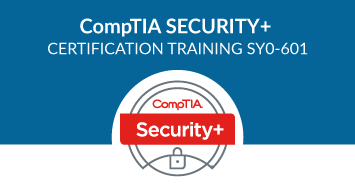CompTIA Security+ Certification Course - SY0-701

A great partnership between CertOcean and CompTIA security+, the certification is once in a lifetime opportunity for you to indulge in a global certification that develops your core cybersecurity skills indispensable for security and network administrators. This training program is ideal for professionals who want to add qualities in risk management, risk mitigation, threat management, and intrusion detection. The CompTIA Security+ Certification Course empowers you to handle all security-related incidents and not just analyze and identify them. CertOcean’s CompTIA Security+ certification was designed and developed to accomplish personal benchmarks and make themselves more pro and master in IT security. Post completion, you learn the fundamental skills in the security and network domain.
Why should you do CompTIA Security+?
Globally acclaimed companies like Dell, Accenture, Capgemini, Intel, HP, Verizon, and many more well-established companies have CompTIA Security+ certification mandatory for candidates applying for various security roles.
The average salary for a CompTIA Security+ candidates varies from $84,000 - $120,000 as per top job portals.
Since a breach in an organization’s security and network walls has become quite common, a demand for certified professionals adept in the latest cybersecurity countermeasures is quite prevalent. CompTIA Security+ certification will serve as a stepping stone in your career.
Course Curriculum
Learning Objective: This section details social engineering techniques, determine the type of attack, associate application, and network attacks, explain different threat actors, vectors, and sources and understand different vulnerabilities.
Topics:
Security Policy
Threat Actors
Social Engineering
Phishing & Types of Malware
Trojans and Spyware
Security Control Types
Defense in Depth
Frameworks and Compliance
Vulnerability Scanning and Pen Tests
Security Assessment Techniques
Pen Testing Concepts
Vulnerability Scanning Concepts
Exploitation Frameworks
Learning Objective: This section details social engineering techniques, determine the type of attack, associate application, and network attacks, explain different threat actors, vectors, and sources and understand different vulnerabilities.
Topics:
Security Policy
Threat Actors
Social Engineering
Phishing & Types of Malware
Trojans and Spyware
Security Control Types
Defense in Depth
Frameworks and Compliance
Vulnerability Scanning and Pen Tests
Security Assessment Techniques
Pen Testing Concepts
Vulnerability Scanning Concepts
Exploitation Frameworks
Learning Objective: Learn the basics of cryptographic concepts, implement symmetric, and asymmetric algorithms, understand attacks and how to mitigate them.
Topics:
Cryptographic Terminology and Ciphers
Cryptographic Products
Hashing Algorithms
Symmetric Algorithms
Asymmetric Algorithms
Diffie-Hellman and Elliptic Curve
Transport Encryption
Cryptographic Attacks
PKI Standards
Digital Certificates
Certificate Authorities
Types of Certificate
Implementing PKI
Storing and Distributing Keys
Key Status and Revocation
PKI Trust Models
PGP / GPG
Learning Objective: Learn about the authentication and authorization design concepts, account management controls, and understand LDAP and Active Directory.
Topics:
Access Control Systems
Identification & Authentication
LAN Manager / NTLM
Kerberos
PAP, CHAP, and MS-CHAP
Password Attacks
Token-based & Biometric Authentication
Common Access Card
Authorization
Directory Services
RADIUS and TACACS+
Federation and Trusts
Federated Identity Protocols
Formal Access Control Models
Account Types
Windows Active Directory
Creating and Managing Accounts
Account Policy Enforcement
Credential Management Policies
Account Restrictions
Accounting and Auditing
Learning Objective: Understand the network security, implement secure network design, and install and configure security appliances.
Topics:
Network Zones and Segments
Subnetting
Switching Infrastructure
Switching Attacks and Hardening
Endpoint Security
Network Access Control
Routing Infrastructure
Network Address Translation
Software-Defined Networking
Basic & Stateful Firewalls
Implementing a Firewall or Gateway
Web Application Firewalls
Proxies and Gateways
Denial of Service Attacks
Load Balancers
Learning Objective: Explain and study the implications of embedded and specialized systems, host applications security solutions, configure wireless security solutions, learn hardening concepts, deploying secure host embedded systems.
Topics:
Wireless LANs
WEP and WPA
Wi-Fi Authentication
Extensible Authentication Protocol
Wi-Fi Site Security
Personal Area Networks
Trusted Computing
Hardware / Firmware Security
Peripheral Device Security
Secure Configurations
OS Hardening
Patch Management
Embedded Systems
Security for Embedded System
Learning Objective: Understand the important security protocols used, secure network access protocols, and secure network applications.
Topics:
DHCP Security
DNS Security
Network Management Protocols
HTTP and Web Servers
SSL / TLS and HTTPS
Web Security Gateways
Email Services
S/MIME
File Transfer
Voice and Video Services
Voice over IP (VoIP)
Remote Access Architecture
Virtual Private Networks
IPsec and IKE
Remote Access Servers
Remote Administration Tools
Hardening Remote Access Infrastructure
Learning Objective: Study the cloud computing basics, the importance of physical security controls, secure mobile applications, apply cybersecurity solutions to the cloud.
Topics:
Mobile Device Deployments
Mobile Connection Methods
Mobile Access Control Systems
Enforcement and Monitoring
Virtualization Technologies
Virtualization Security Best Practices
Cloud Computing
Cloud Security Best Practices
Site Layout and Access
Gateways and Locks
Alarm Systems
Surveillance
Hardware Security
Environmental Controls
Learning Objective: Study application development, deployment, and automation concepts, risk management, and the importance of application regulations, standards, and frameworks.
Topics:
Business Impact Analysis
Identification of Critical Systems
Risk Assessment
Risk Mitigation
Application Vulnerabilities
Application Exploits
Web Browser Exploits
Secure Application Design
Secure Coding Concepts
Auditing Applications
Secure DevOps
Learning Objective: Study the importance of cybersecurity resilience, digital forensics, disaster recovery concepts, organizational security, privacy, and security data concepts.
Topics:
Continuity of Operations Planning
Disaster Recovery Planning
Resiliency Strategies
Recovery Sites
Backup Plans and Policies
Resiliency and Automation Strategies
Corporate Security Policy
Personnel Management Policies
Interoperability Agreements
Data Roles
Data Sensitivity Labeling and Handling
Data Wiping and Disposal
Privacy and Employee Conduct Policies
Security Policy Training
Forensic Procedures
Collecting Evidence
Capturing System Images
Handling and Analyzing Evidence
Course Description
CertOcean’s CompTIA Security Training Certificate is designed and developed to prepare professionals who want to establish a career in cybersecurity. Post the completion of the course, you will develop core knowledge and hands-on experience in troubleshooting networks, techniques in risk management, risk mitigation, threat management, intrusion detection, etc.
Post the completion of the course, you will learn about:
Potent vulnerabilities and threats that may cause harm to a system or network
Corrective measures for incident response
Implement cryptographic standards and products
Install, configure, and deploy network components, identity and access services (Identity & Access Management), and management controls
Learn the principles of organizational security and the elements of effective security policies
Implement secure network system design and architecture concepts
Remote access and wireless security is enforced
Risks and take corrective measures for risk mitigation and management
Identify strategies for fault tolerance, ensuring business continuity, and disaster recovery
Features
Instructor-led live sessions
32 Hours of Online Live Instructor-led Classes. Training Schedule: 10 sessions.
Lifetime access
Students will get lifetime access to all the course materials where presentations, quizzes, installation guides, and class recordings are available.
24/7 expert support:
We have a lifetime 24x7 online support team to resolve all your technical queries, through a ticket based tracking system.
Certification:
Once you have completed your final course training and project, you will receive a certificate of CompTIA Security+.
Frequently Asked Questions (FAQs):
To clear the exam, you need a minimum score of 750. The exam duration is 90 minutes and includes 90 questions.
The eligibility requirements include:
At least two years of experience in IT security administration
Hands-on experience in technical information security
Broad knowledge of security concepts



